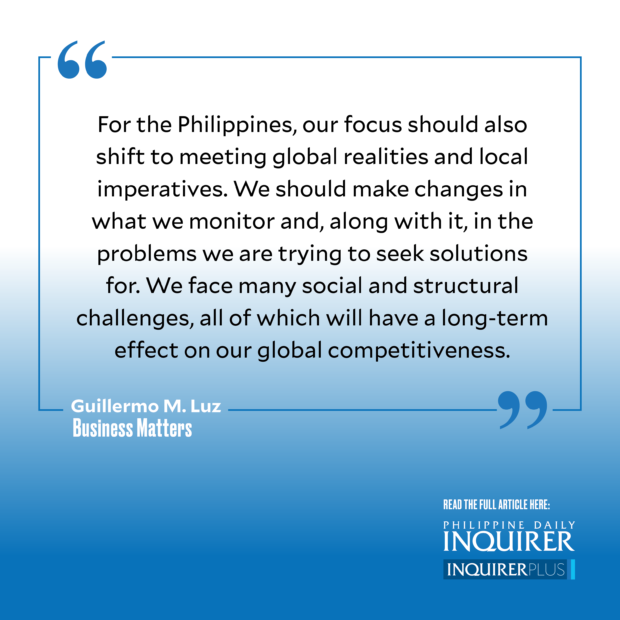Measuring our global competitiveness
For many years, we have tracked how the country has performed in global competitiveness rankings. Starting with the early work of the Makati Business Club on the World Economic Forum’s (WEF) Global Competitiveness Report and the Asian Institute of Management on the IMD World Competitiveness Report in the early 1990s, the National Competitiveness Council (NCC) expanded the coverage to include the World Bank/IFC’s Ease of Doing Business Report, Transparency International’s Corruption Perceptions Index, Heritage Foundation’s Economic Freedom Index, WEF’s Travel and Tourism Report, World Intellectual Property Organization’s Global Innovation Index, Global Information Technology Report/NetworkReadiness Index, UNDP’s E-Government Development Index, and World Bank’s Logistics Performance Index, among others. The NCC covered 12 indices in all to analyze and look for solutions to improve the country’s competitiveness standing in the world and, most importantly, within Asean.
But the world has changed dramatically over the last two-and-a-half years due to COVID-19. Some institutes have stopped or deferred issuing reports since 2020. In reality, the thinking behind what indicators to measure has been slowly evolving over a longer period. The pandemic has merely accelerated that shift, especially with respect to public health readiness.
For the Philippines, our focus should also shift to meeting global realities and local imperatives. We should make changes in what we monitor and, along with it, in the problems we are trying to seek solutions for. We face many social and structural challenges, all of which will have a long-term effect on our global competitiveness.
I’d like to propose some global reports worth considering for closer monitoring.
Programme for International Student Assessment (Pisa) measures the ability of 15-year-olds to use reading, math, and science skills to meet real-life challenges. Considered one of the most comprehensive and rigorous international assessments of students, Pisa is published once every three years by the Organization for Economic Cooperation Development, with the last report issued in 2018. The Philippines was covered for the first time in the 2018 report and did not do well. We ranked last in the group of 79 countries measured for reading and No. 78 in science and math. We should do better. Otherwise, our overall global competitiveness will never improve significantly.
Global Health Security Index, published by Johns Hopkins Center and Nuclear Threat Initiative, measures national health security and capability to handle disease outbreaks and manage epidemics and pandemics. In the last report issued (2020), the Philippines ranked No. 57 out of 195 countries measured. Prior to 2020, we never looked at public health assessments in the business community, but our experience with COVID-19 opened our eyes to this challenge. Some studies indicate that the probability of another pandemic in the next 10 or more years is moderately high.
Global Nutrition Report covers the state of malnutrition in the world. It covers a wide range of nutrition targets such as childhood stunting, low birth weight, childhood wasting, and other important nutrition-related indicators. The report gives detailed country reports that are useful for keeping track of performance versus targets. Incidentally, our own National Nutrition Council maintains very detailed data on malnutrition and nutrition in the Philippines. Why is this important? Any investment we make in education and health will be wasted if we do not address our national malnutrition and hunger challenge.
Other indices worth tracking include the Environmental Performance Index (by Yale and Columbia Universities with the World Economic Forum), Energy Transition Index (by the World Economic Forum), World Digital Competitiveness Ranking (by IMD), and the World Risk Index. Each of these reports tracks something of importance to the long-term competitiveness and development goals of the country.
The key question is: who will, or can monitor all these reports? From 2011 to 2018, the NCC monitored 12 global reports. Moving forward, the responsibility can be given to different agencies. However, in order to get a more holistic picture and develop a strategy to meet these different challenges, it might make more sense to assign this responsibility to a single agency or an interagency body.
As the old saying goes, “what gets measured, gets managed.”
* * *
Guillermo M. Luz served as private sector co-chair of the National Competitiveness Council from 2011 to 2018.
Business Matters is a project of the Makati Business Club (makatibusinessclub@mbc.com.ph).
MORE ‘BUSINESS MATTERS’ COLUMNS





















